Louvre Pyramid
The Louvre Pyramid (Pyramide du Louvre) is a large glass and metal pyramid designed by Chinese-American architect I. M. Pei, surrounded by three smaller pyramids, in the main courtyard (Cour Napoléon) of the Louvre Palace (Palais du Louvre) in Paris. The large pyramid serves as the main entrance to the Louvre Museum. Completed in 1989,[1] it has become a landmark of the city of Paris.
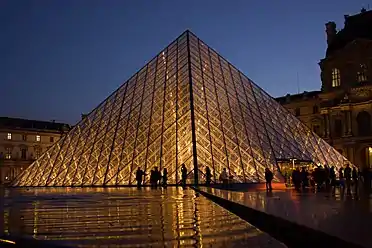
Design and construction
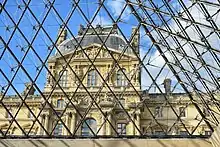
Commissioned by the President of France, François Mitterrand, in 1984, it was designed by Chinese-American architect I. M. Pei. The structure, which was constructed entirely with glass segments and metal poles, reaches a height of 21.6 metres (71 ft).[2] Its square base has sides of 34 metres (112 ft) and a base surface area of 1,000 square metres (11,000 sq ft).[3] It consists of 603 rhombus-shaped and 70 triangular glass segments.[2] The pyramid structure was engineered by Nicolet Chartrand Knoll Ltd. of Montreal (Pyramid Structure / Design Consultant) and Rice Francis Ritchie of Paris (Pyramid Structure / Construction Phase).[4]
The pyramid and the underground lobby beneath it were created because of a series of problems with the Louvre's original main entrance, which could no longer handle the enormous number of visitors on an everyday basis. Visitors entering through the pyramid descend into the spacious lobby then ascend into the main Louvre buildings.
For design historian Mark Pimlott, "I.M. Pei’s plan distributes people effectively from the central concourse to myriad destinations within its vast subterranean network... the architectonic framework evokes, at gigantic scale, an ancient atrium of a Pompeiian villa; the treatment of the opening above, with its tracery of engineered castings and cables, evokes the atria of corporate office buildings; the busy movement of people from all directions suggests the concourses of rail termini or international airports."[5]
Several other museums have duplicated this concept, most notably the Museum of Science and Industry in Chicago. The Dolphin Centre, featuring a similar pyramid, was opened in April 1982, by Prince Richard, Duke of Gloucester.[6] The construction work on the pyramid base and underground lobby was carried out by the Vinci construction company.[7]
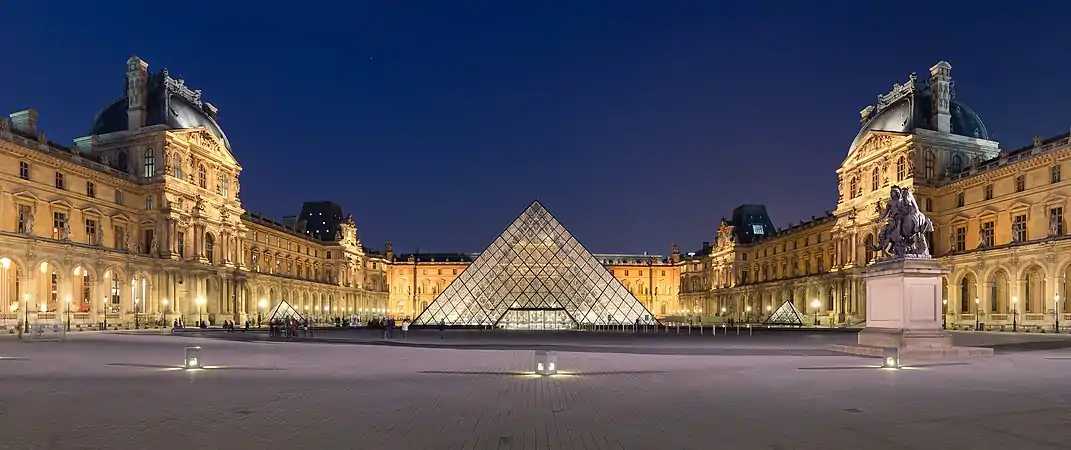 The Courtyard of the Louvre Museum at night.
The Courtyard of the Louvre Museum at night.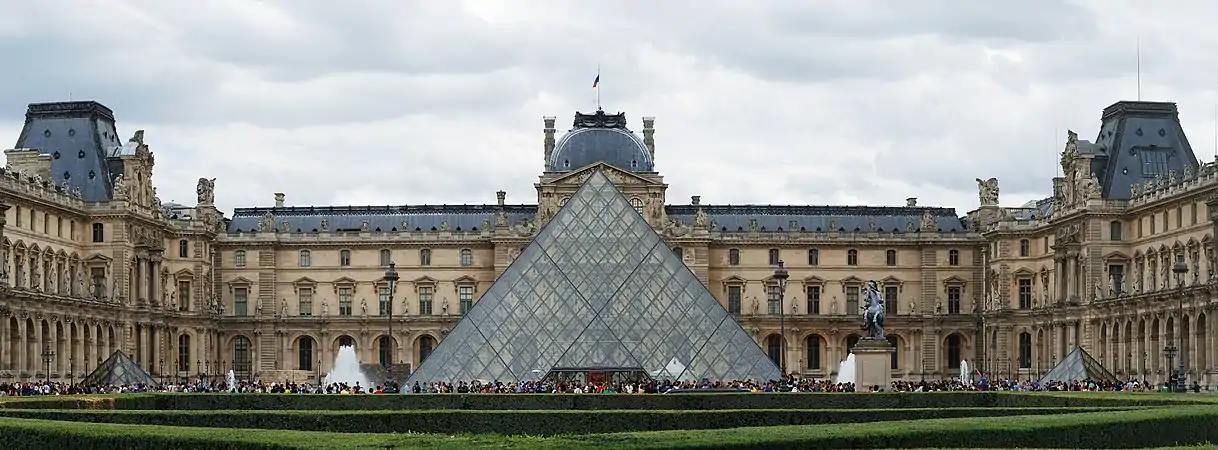 The Courtyard of the Louvre Museum during the day.
The Courtyard of the Louvre Museum during the day.
Aesthetic and political debate over its design
The construction of the pyramid triggered many years of strong and lively aesthetic and political debate.[8] Criticisms tended to fall into four areas: (1) the modernist style of the edifice being inconsistent with the classic French Renaissance style and history of the Louvre; (2) the pyramid being an unsuitable symbol of death from ancient Egypt; (3) the project being an immodest, pretentious, megalomaniacal folly imposed by then-President François Mitterrand; and (4) Chinese-American architect I.M. Pei being insufficiently French to be entrusted with the task of updating the treasured Parisian landmark.[9]
Those criticizing the aesthetics said it was "sacrilegious" to tamper with the Louvre's majestic old French Renaissance architecture, and called the pyramid an anachronistic intrusion of an Egyptian death symbol in the middle of Paris.[10] Meanwhile, political critics referred to the structure as Pharaoh Francois' Pyramid.[9] Writing in The Nation, Alexander Cockburn ridiculed Pei's rationale that the structure would help visitors locate the entrance: "What Pei really meant was that in our unfolding fin de siècle, public institutions need an area ... where rich people can assemble for cocktail parties, banquets and kindred functions, to which the word 'charity' is attached to satisfy bodies such as the IRS."[11] Many still continue to feel the harsh modernism of the edifice is out of place.[12][13][14]
During the design phase, there was a proposal that the design include a spire on the pyramid to simplify window washing. Pei objected, however, and this proposal was eliminated.
History
In 1839, according to one newspaper account, in ceremonies commemorating the "glorious revolution" of 1830, "The tombs of the Louvre were covered with black hangings and adorned with tricolored flags. In front and in the middle was erected an expiatory monument of a pyramidal shape, and surmounted by a funeral vase."[15]
Number of panes
The pyramid has a total of 673 panes, as confirmed by the Louvre,[2] 603 rhombi and 70 triangles. Three sides have 171 panes each: 18 triangular ones on the edges and 153 rhombic ones arranged in a triangle;[16] the fourth side, with the entrance, has 9 fewer rhombic and 2 fewer triangular ones, giving 160.[17] Some commentators report that Pei's office counts 689.[18]
However, a longstanding rumor claims that the pyramid includes exactly 666 panes, "the number of the beast", often associated with Satan. The story of the 666 panes originated in the 1980s, when the official brochure published during construction cited this number twice. The number 666 was also mentioned in various newspapers. One writer on esoteric architecture asserted that "the pyramid is dedicated to a power described as the Beast in the Book of Revelation.... The entire structure is based on the number 6."[19]
The myth resurfaced in 2003, with the protagonist of the best-selling novel The Da Vinci Code saying: "this pyramid, at President Mitterrand's explicit demand, had been constructed of exactly 666 panes of glass — a bizarre request that had always been a hot topic among conspiracy buffs who claimed 666 was the number of Satan."[20] In fact, according to Pei's office, Mitterand never specified the number of panes.[18]
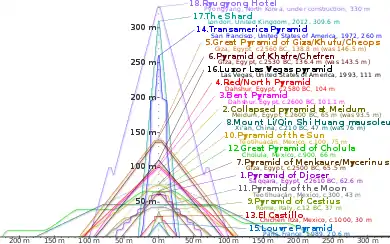
Pyramide Inversée
The Pyramide Inversée (Inverted Pyramid) is a skylight in the Carrousel du Louvre shopping mall in front of the Louvre Museum. It looks like an upside-down and smaller version of the Louvre Pyramid.
Renovation
Designed for a museum that attracted 4.5 million visitors a year, the pyramid proved inadequate by the time the Louvre's attendance had doubled in 2014. Between 2014 and 2017, the layout of the foyer area in the Cour Napoleon beneath the glass pyramid underwent a thorough redesign, including better access to the pyramid and the Passage Richelieu.[21]
Pei's other glass pyramids
The same year the Louvre Pyramid opened, Pei included large glass pyramids on the roofs of the IBM Somers Office Complex he designed in Westchester County, New York.[22] Pei returned again to the glass pyramid concept at the Rock and Roll Hall of Fame in Cleveland, Ohio, opened in 1995.[22]
See also
 France portal
France portal
References
- Simons, Marlise (28 March 1993). "5 Pieces of Europe's Past Return to Life: France; A vast new exhibition space as the Louvre renovates". The New York Times. Retrieved 7 October 2008.
- "Architecture: Louvre Pyramid". Glass on the Web. June 2005. Archived from the original on 12 January 2002. Retrieved 16 January 2011.
- Official Press Release, Louvre. ""Pyramid" Project Launch: The Musée du Louvre is improving visitor reception (2014-2016)" (PDF). Louvre. p. 10. Retrieved 16 May 2016.
- "Grand Louvre: Phase I". Pei Cobb Freed & Partners. Retrieved 16 January 2011.
- Pimlott, Mark (2007). "The Grand Louvre & I.M. Pei". Without and Within: Essays on Territory and the Interior (Excerpt). Rotterdam: Episode Publishers. Retrieved 13 August 2012 – via artdesigncafe.
- Steer, Phil. "Dolphin Centre: Brief History". Romford Now & Then. Archived from the original on 23 November 2011.
- "History". Vinci. Archived from the original on 1 October 2011. Retrieved 16 January 2011.
- Tempest, Rone. "Controversial New Pyramid Entrance to the Louvre Opens in Paris". Los Angeles Times. Retrieved 16 May 2016.
- Bernstein, Richard (24 November 1985). "I.M. Pei's Pyramid: A Provocative Plan for The Louvre". The New York Times. The New York Times. Retrieved 16 May 2016.
- Goldberger, Paul. "Pei Pyramid and New Louvre Open Today". The New York Times. The New York Times. Retrieved 16 May 2016.
- Cockburn, Alexander (26 April 1986). "The Private Use of Public Spaces". The Nation.
- Stamberg, Susan. "Landmark At The Louvre: The Pyramid Turns 20". NPR. National Public Radio. Retrieved 16 May 2016.,
- Carbone, Ken. "Viva Le Louvre! At 20, I.M. Pei's Controversial Pyramid Defies Critics". Fast Company. Mansueto Ventures, LLC. Retrieved 16 May 2016.
- Souza, Eduardo. "AD Classics: Le Grande Louvre / I.M. Pei". Arch Daily. Plataforma Networks Broadcasting Architecture Worldwide. Retrieved 16 May 2016.
- "The Paris Sketch Book Of Mr. M. A. Titmarsh". Project Gutenberg.
- the 17th triangular number is
- The Glazing manufucturer, Saint-Gobain, states that there are "675 lozenges and 118 triangles," making 793 total glass panes ("A Raw Diamond Cut From Glass", Saint Gobain website). However, these numbers appear to also include the panes in the three smaller pyramids on the north, east, and south sides of the main pyramid.
- Secrets of the Code, edited by Dan Burstein, p. 259.
- Dominique Setzepfandt, François Mitterrand, Grand Architecte de l'Univers, 1998, ISBN 290976902X
- Dan Brown. The Da Vinci Code, p. 21.
- Pes, Javier (28 April 2014). "Louvre's Director Makes Unblocking Pyramid Bottleneck a Priority". The Art Newspaper. Archived from the original on 29 April 2014.CS1 maint: unfit URL (link)
- https://qz.com/1621464/how-i-m-pei-reinvented-the-pyramid/
.jpg.webp)